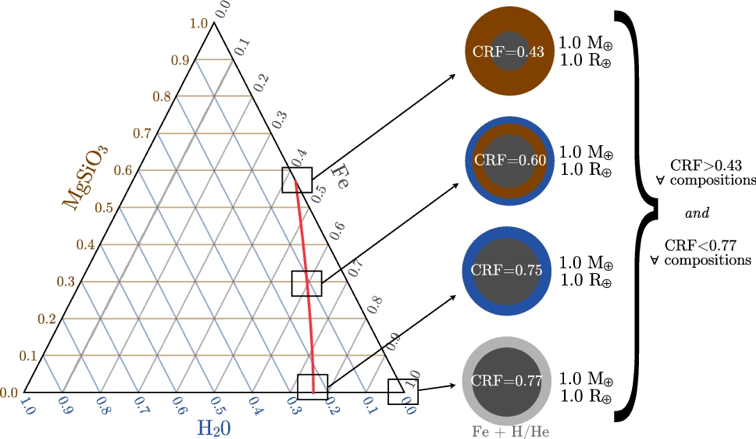HARDCORE Model
Understanding the internal structure of an exoplanet is a crucial step in determining its habitability. Unfortunately, we know very little about the composition of extrasolar worlds. In general, the only relevant information we do have is the mass and radius, which alone cannot reveal how much iron, silicon or water a solid planet is comprised of, let alone its core radius fraction (CRF). While this degeneracy is a daunting obstacle, HARDCORE takes a unique approach by exploiting boundary conditions to solve for the minimum and maximum core radius fraction (CRFmin & CRFmax). With both bounds in hand, a marginal CRF can also be inferred by sampling in between.
For our model to hold true, we make several assumptions:
- The planet is fully differentiated.
- The planet has no layers denser than iron.
- If the planet has an outer volatile envelope, it has negligible mass.
The boundary conditions HARDCORE exploits can be described by Figure 1. Although each planet shown has a different interior composition, the planets are indistinguishable when only considering the observable parameters (mass and radius). However, the planet of a set mass and radius will always have the smallest core size if that planet is composed solely of an iron core and a silicate mantle. Likewise, a planet of a set mass and radius will always have the largest core size if that planet is composed solely of an iron core and a volatile envelope of negligible mass.
For more information about our model, please see Suissa et al. (2018).
For a video explaining the model to public audiences, please click here.
For the original HARDCORE code, visit https://github.com/gsuissa/hardCORE.

Figure 1. Ternary diagram of a three-layer interior structure model for a solid planet. All points along the red line lead to a M = 1 M⊙ and R = 1 R⊙ planet (Suissa et al. 2018, MNRAS, 476, 2).
Output Values
| Name | Value |
|---|---|
| Minimum core radius fraction (CRFmin) | |
| Marginal core radius fraction (CRFmarg) | |
| Maximum core radius fraction (CRFmax) |